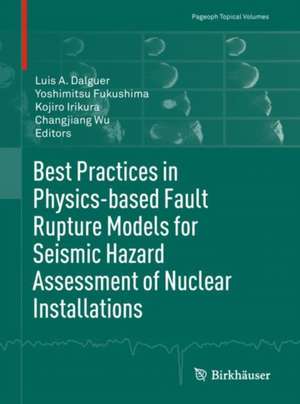Best Practices in Physics-based Fault Rupture Models for Seismic Hazard Assessment of Nuclear Installations: Pageoph Topical Volumes
Editat de Luis A. Dalguer, Yoshimitsu Fukushima, Kojiro Irikura, Changjiang Wuen Limba Engleză Paperback – 2 ian 2018
Din seria Pageoph Topical Volumes
-
 Preț: 300.85 lei
Preț: 300.85 lei -
 Preț: 386.19 lei
Preț: 386.19 lei -
 Preț: 303.07 lei
Preț: 303.07 lei -
 Preț: 306.14 lei
Preț: 306.14 lei - 15%
 Preț: 720.73 lei
Preț: 720.73 lei -
 Preț: 397.38 lei
Preț: 397.38 lei -
 Preț: 314.52 lei
Preț: 314.52 lei - 15%
 Preț: 641.71 lei
Preț: 641.71 lei -
 Preț: 221.70 lei
Preț: 221.70 lei -
 Preț: 328.35 lei
Preț: 328.35 lei - 15%
 Preț: 726.94 lei
Preț: 726.94 lei -
 Preț: 308.55 lei
Preț: 308.55 lei -
 Preț: 320.20 lei
Preț: 320.20 lei -
 Preț: 384.70 lei
Preț: 384.70 lei -
 Preț: 301.10 lei
Preț: 301.10 lei -
 Preț: 298.66 lei
Preț: 298.66 lei -
 Preț: 299.34 lei
Preț: 299.34 lei -
 Preț: 324.18 lei
Preț: 324.18 lei -
 Preț: 392.75 lei
Preț: 392.75 lei -
 Preț: 312.97 lei
Preț: 312.97 lei -
 Preț: 307.88 lei
Preț: 307.88 lei -
 Preț: 387.96 lei
Preț: 387.96 lei -
 Preț: 405.06 lei
Preț: 405.06 lei -
 Preț: 386.00 lei
Preț: 386.00 lei -
 Preț: 396.40 lei
Preț: 396.40 lei -
 Preț: 404.29 lei
Preț: 404.29 lei -
 Preț: 391.99 lei
Preț: 391.99 lei -
 Preț: 351.49 lei
Preț: 351.49 lei - 18%
 Preț: 1111.85 lei
Preț: 1111.85 lei -
 Preț: 393.52 lei
Preț: 393.52 lei - 20%
 Preț: 568.73 lei
Preț: 568.73 lei -
 Preț: 388.72 lei
Preț: 388.72 lei -
 Preț: 380.07 lei
Preț: 380.07 lei - 15%
 Preț: 660.83 lei
Preț: 660.83 lei -
 Preț: 396.40 lei
Preț: 396.40 lei -
 Preț: 397.38 lei
Preț: 397.38 lei -
 Preț: 409.30 lei
Preț: 409.30 lei -
 Preț: 399.29 lei
Preț: 399.29 lei -
 Preț: 495.62 lei
Preț: 495.62 lei -
 Preț: 385.25 lei
Preț: 385.25 lei -
 Preț: 394.29 lei
Preț: 394.29 lei - 15%
 Preț: 647.27 lei
Preț: 647.27 lei -
 Preț: 400.47 lei
Preț: 400.47 lei -
 Preț: 395.25 lei
Preț: 395.25 lei - 15%
 Preț: 657.08 lei
Preț: 657.08 lei -
 Preț: 400.26 lei
Preț: 400.26 lei -
 Preț: 352.80 lei
Preț: 352.80 lei -
 Preț: 384.48 lei
Preț: 384.48 lei -
 Preț: 401.42 lei
Preț: 401.42 lei
Preț: 386.00 lei
Nou
Puncte Express: 579
Preț estimativ în valută:
73.87€ • 76.65$ • 61.74£
73.87€ • 76.65$ • 61.74£
Carte tipărită la comandă
Livrare economică 11-17 martie
Preluare comenzi: 021 569.72.76
Specificații
ISBN-13: 9783319727080
ISBN-10: 3319727087
Pagini: 292
Ilustrații: VI, 338 p. 212 illus., 155 illus. in color.
Dimensiuni: 193 x 260 mm
Greutate: 0.64 kg
Ediția:1st ed. 2018
Editura: Springer International Publishing
Colecția Birkhäuser
Seria Pageoph Topical Volumes
Locul publicării:Cham, Switzerland
ISBN-10: 3319727087
Pagini: 292
Ilustrații: VI, 338 p. 212 illus., 155 illus. in color.
Dimensiuni: 193 x 260 mm
Greutate: 0.64 kg
Ediția:1st ed. 2018
Editura: Springer International Publishing
Colecția Birkhäuser
Seria Pageoph Topical Volumes
Locul publicării:Cham, Switzerland
Cuprins
Best Practices in Physics-Based Fault Rupture Models for Seismic Hazard Assessment of Nuclear Installations.- Surface Rupture Effects on Earthquake Moment-Area Scaling Relations.- Dynamic Rupture Modelling of the 1999 Düzce, Turkey Earthquake.- Dynamic Rupture Simulations Based on the Characterized Source Model of the 2011 Tohoku Earthquake.- Quantification of Fault-Zone Plasticity Effects with Spontaneous Rupture Simulations.- Synthetic Source Inversion Tests with the Full Complexity of Earthquake Source Processes, Including Both Supershear Rupture and Slip Reactivation.- Accounting for Fault Roughness in Pseudo-Dynamic Ground-Motion Simulations.- Within-Event and Between-Events Ground Motion Variability from Earthquake Rupture Scenarios.- Azimuthal Dependence of the Ground Motion Variability from Scenario Modeling of the 2014 Mw6.0 South Napa, California, Earthquake Using an Advanced Kinematic Source Model.- Near-Fault Broadband Ground Motion Simulations Using Empirical Green’s Functions: Application to the Upper Rhine Graben (France–Germany) Case Study.- Broadband Ground Motion Simulation of the 2004 and 1977 Vrancea, Romania, Earthquakes Using Empirical Green’s Function Method.- Mechanisms for Generation of Near-Fault Ground Motion Pulses for Dip-Slip Faulting.- Performance of Irikura Recipe Rupture Model Generator in Earthquake Ground Motion Simulations with Graves and Pitarka Hybrid Approach.- High Attenuation Rate for Shallow, Small Earthquakes in Japan.- Stochastic Earthquake Rupture Modeling Using Nonparametric Co-Regionalization.- Assessment of Simulated Ground Motions in Earthquake Engineering Practice: A Case Study for Duzce (Turkey).- Challenges Ahead for Nuclear Facility Site-Specific Seismic Hazard Assessment in France: The Alternative Energies and the Atomic Energy Commission (CEA) Vision.- Physics-Based Hazard Assessment for Critical Structures Near Large Earthquake Sources.
Textul de pe ultima copertă
This volume collects several extended articles from the first workshop on Best Practices in Physics-based Fault Rupture Models for Seismic Hazard Assessment of Nuclear Installations (BestPSHANI). Held in 2015, the workshop was organized by the IAEA to disseminate the use of physics-based fault-rupture models for ground motion prediction in seismic hazard assessments (SHA). The book also presents a number of new contributions on topics ranging from the seismological aspects of earthquake cycle simulations for source scaling evaluation, seismic source characterization, source inversion and physics-based ground motion modeling to engineering applications of simulated ground motion for the analysis of seismic response of structures. Further, it includes papers describing current practices for assessing seismic hazard in terms of nuclear safety in low seismicity areas, and proposals for physics-based hazard assessment for critical structures near large earthquakes. The papers validate and verify the models by comparing synthetic results with observed data and empirical models. The book is a valuable resource for scientists, engineers, students and practitioners involved in all aspects of SHA.
Caracteristici
Includes supplementary material: sn.pub/extras
